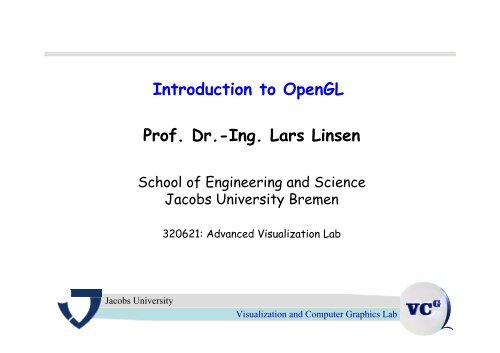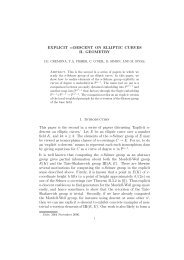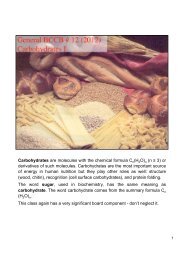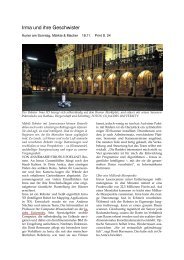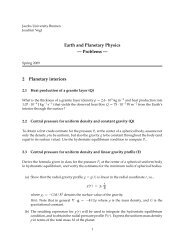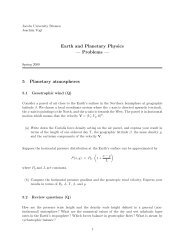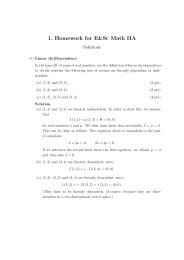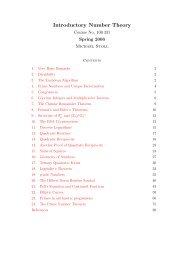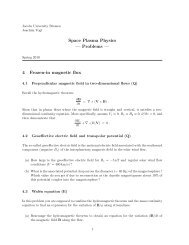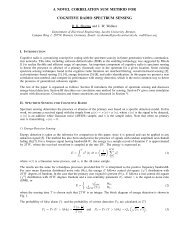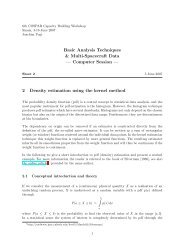Introduction to OpenGL Prof. Dr.-Ing. Lars Linsen - Faculty.jacobs ...
Introduction to OpenGL Prof. Dr.-Ing. Lars Linsen - Faculty.jacobs ...
Introduction to OpenGL Prof. Dr.-Ing. Lars Linsen - Faculty.jacobs ...
Create successful ePaper yourself
Turn your PDF publications into a flip-book with our unique Google optimized e-Paper software.
Jacobs University<br />
<strong>Introduction</strong> <strong>to</strong> <strong>OpenGL</strong><br />
<strong>Prof</strong>. <strong>Dr</strong>.-<strong>Ing</strong>. <strong>Lars</strong> <strong>Linsen</strong><br />
School of Engineering and Science<br />
Jacobs University Bremen<br />
320621: Advanced Visualization Lab<br />
Visualization and Computer Graphics Lab
Jacobs University<br />
1. What is <strong>OpenGL</strong>?<br />
Visualization and Computer Graphics Lab
Jacobs University<br />
Graphics Programming<br />
• Graphical user interface (GUI)<br />
• Windowing system<br />
– X<br />
– Integrated in OS: Microsoft Windows, Mac OS<br />
• Microsoft Direct3D<br />
• <strong>OpenGL</strong> (Open Graphics Library)<br />
• <strong>OpenGL</strong> 2.0 (and higher)<br />
– GLSL (GL Shading Language)<br />
• Cg (nVidia)<br />
• HLSL (high level shader language, DirectX)<br />
• GPGPU programming: CUDA (nVidia), CTM (ATI),<br />
OpenCL<br />
Visualization and Computer Graphics Lab<br />
320621: Advanced Visualization Lab 3
Jacobs University<br />
What is <strong>OpenGL</strong>?<br />
• <strong>OpenGL</strong> is a software interface for 3D computer graphics<br />
• Originally developed by SGI (IRIS GL)<br />
since 1992 under control of ARB (Architecture Review Board)<br />
• <strong>OpenGL</strong> specification is<br />
• hardware-independent,<br />
• window system independent and<br />
• operating system independent.<br />
• Different implementations (as hardware and/or software)<br />
•C library<br />
Visualization and Computer Graphics Lab<br />
320621: Advanced Visualization Lab 4
CPU<br />
Jacobs University<br />
<strong>OpenGL</strong> Architecture<br />
Polynomial<br />
Evalua<strong>to</strong>r<br />
Display<br />
List<br />
Pixel<br />
Operations<br />
Per Vertex<br />
Operations &<br />
Primitive<br />
Assembly<br />
Rasterization<br />
Texture<br />
Memory<br />
Per Fragment<br />
Operations<br />
Visualization and Computer Graphics Lab<br />
320621: Advanced Visualization Lab 5<br />
Frame<br />
Buffer
Jacobs University<br />
<strong>OpenGL</strong> as a Renderer<br />
• Geometric primitives<br />
– points, lines, and polygons<br />
• Image Primitives<br />
– images and bitmaps<br />
• Separate pipeline for images and geometry<br />
– linked through texture mapping<br />
• Rendering depends on state<br />
– colors, materials, light sources, etc.<br />
Visualization and Computer Graphics Lab<br />
320621: Advanced Visualization Lab 6
Setting State<br />
Controlling current state<br />
Jacobs University<br />
glPointSize( size );<br />
glLineStipple( repeat, pattern );<br />
glShadeModel( GL_SMOOTH );<br />
Enabling Features<br />
glEnable( GL_LIGHTING );<br />
glDisable( GL_TEXTURE_2D );<br />
Visualization and Computer Graphics Lab<br />
320621: Advanced Visualization Lab 7
Number of<br />
components<br />
2 - (x,y)<br />
3 - (x,y,z)<br />
4 - (x,y,z,w)<br />
<strong>OpenGL</strong> Command Formats<br />
Jacobs University<br />
glVertex3fv( v )<br />
Data Type<br />
b - byte<br />
ub - unsigned byte<br />
s - short<br />
us - unsigned short<br />
i - int<br />
ui - unsigned int<br />
f - float<br />
d - double<br />
Vec<strong>to</strong>r<br />
omit “v” for<br />
scalar form<br />
glVertex2f( x, y )<br />
Visualization and Computer Graphics Lab<br />
320621: Advanced Visualization Lab 8
• AGL, GLX, WGL<br />
Jacobs University<br />
Related APIs<br />
– glue between <strong>OpenGL</strong> and windowing systems<br />
• GLU (<strong>OpenGL</strong> Utility Library)<br />
– part of <strong>OpenGL</strong><br />
– NURBS, tessella<strong>to</strong>rs, quadric shapes, etc.<br />
• GLUT (<strong>OpenGL</strong> Utility Toolkit)<br />
– portable windowing API<br />
– not officially part of <strong>OpenGL</strong><br />
Visualization and Computer Graphics Lab<br />
320621: Advanced Visualization Lab 9
<strong>OpenGL</strong> and Related APIs<br />
<strong>OpenGL</strong> Motif<br />
widget or similar<br />
Jacobs University<br />
GLX, AGL<br />
or WGL<br />
X, Win32, Mac O/S<br />
application program<br />
GLUT<br />
GLU<br />
software and/or hardware<br />
GL<br />
Visualization and Computer Graphics Lab<br />
320621: Advanced Visualization Lab 10
• Headers Files<br />
• #include <br />
• #include <br />
• #include <br />
• Libraries<br />
• Enumerated Types<br />
Jacobs University<br />
Preliminaries<br />
– <strong>OpenGL</strong> defines numerous types for compatibility<br />
– GLfloat, GLint, GLenum, etc.<br />
Visualization and Computer Graphics Lab<br />
320621: Advanced Visualization Lab 11
Jacobs University<br />
2. Getting Started<br />
Visualization and Computer Graphics Lab
Getting started with <strong>OpenGL</strong><br />
Installation of Mesa3D: http://www.mesa3d.org<br />
Jacobs University<br />
Visualization and Computer Graphics Lab<br />
320621: Advanced Visualization Lab 13
Getting started with <strong>OpenGL</strong><br />
Installation of Mesa3D: http://www.mesa3d.org<br />
Jacobs University<br />
Visualization and Computer Graphics Lab<br />
320621: Advanced Visualization Lab 14
Jacobs University<br />
Setting up GLUT<br />
• To use GLUT its header file has <strong>to</strong> be included in the<br />
source:<br />
– #include <br />
• The program has <strong>to</strong> be linked against the GLUT library<br />
– For GCC just compile with -lglut<br />
– For MSVC and other of the sort add glut <strong>to</strong> the libraries in<br />
the project options<br />
Visualization and Computer Graphics Lab<br />
320621: Advanced Visualization Lab 15
• Application Structure<br />
– Configure and open window<br />
Jacobs University<br />
GLUT Basics<br />
– Initialize <strong>OpenGL</strong> state<br />
– Register input callback functions<br />
• render<br />
• resize<br />
• input: keyboard, mouse, etc.<br />
– Enter event processing loop<br />
Visualization and Computer Graphics Lab<br />
320621: Advanced Visualization Lab 16
Jacobs University<br />
Initializing GLUT<br />
• void glutInit(int argc, char **argv);<br />
– Initializes GLUT library. Should be called before any other<br />
routine. Processes window system specific command line<br />
arguments.<br />
• void glutInitDisplayMode(unsigned int mode);<br />
– Sets the GLUT display mode for windows created with<br />
glutCreateWindow()<br />
– The display mode is a bitwise or combination of GLUT_RGBA<br />
or GLUT_INDEX, GLUT_SINGLE or GLUT_DOUBLE, and any<br />
of the buffer-enabling flags GLUT_DEPTH, GLUT_STENCIL,<br />
or GLUT_ACCUM.<br />
Visualization and Computer Graphics Lab<br />
320621: Advanced Visualization Lab 17
Jacobs University<br />
Initializing GLUT<br />
• void glutInitWindowSize(int width, int height);<br />
– width and height of the window<br />
• void glutInitWindowPosition(int x, int y);<br />
– Sets the coordinates of the <strong>to</strong>p-left corner<br />
• int glutCreateWindow(char *name);<br />
– Creates a window with the name name and returns a unique<br />
window identifying integer (handle). Useful when rendering is<br />
done in multiple windows of the same application.<br />
Visualization and Computer Graphics Lab<br />
320621: Advanced Visualization Lab 18
Handling events with GLUT<br />
• Callback functions are registered <strong>to</strong> the corresponding<br />
event, i.e., when the respective event takes place, the<br />
function is called <strong>to</strong> handle it.<br />
• Window events:<br />
– void glutDisplayFunc(void (*func)(void));<br />
• The function given as argument is called whenever the window has<br />
<strong>to</strong> be redrawn<br />
– void glutReshapeFunc(void (*func)(int width, int height));<br />
• The function is called when the window is resized. Width and<br />
height are the new width and height of the resized window.<br />
• When no function is specified (NULL), a default one is assigned.<br />
Jacobs University<br />
Visualization and Computer Graphics Lab<br />
320621: Advanced Visualization Lab 19
Handling Events with GLUT<br />
• Input events<br />
– void glutKeyboardFunc(void (*func)(unsigned int key, int x, int y);<br />
• The function is called when a key is pressed. Key is the ASCII of<br />
the pressed key, x and y are the mouse coordinates (window<br />
relative) at the moment the key is pressed<br />
– void glutSpecialFunc(void (*func)(int key, int x, int y));<br />
• Triggered when a special key is pressed (F1..F12, arrows, Insert,<br />
Home, etc.).<br />
– void glutMouseFunc(void (*func)(int but<strong>to</strong>n, int state, int x, int y));<br />
• Triggered when a mouse but<strong>to</strong>n is pressed or released. But<strong>to</strong>n is left,<br />
right or middle, state is down or up, x and y are as above.<br />
– void glutMotionFunc(void (*func)(int x, int y));<br />
• Specifies the function that is called when the mouse is moved while<br />
one or more but<strong>to</strong>ns are pressed.<br />
Jacobs University<br />
Visualization and Computer Graphics Lab<br />
320621: Advanced Visualization Lab 20
Handling Events with GLUT<br />
• Redisplaying<br />
– void glutPostRedisplay(void);<br />
• Posts a message <strong>to</strong> the queue that redisplaying is required. At the<br />
first opportunity, the function is called.<br />
• Idling<br />
– void glutIdleFunc(void (*func)(void));<br />
• Function is called when nothing is happening. Sometimes this<br />
function is set <strong>to</strong> the displaying function and timed <strong>to</strong> force a<br />
certain FPS<br />
Jacobs University<br />
Visualization and Computer Graphics Lab<br />
320621: Advanced Visualization Lab 21
Jacobs University<br />
Running the Application<br />
• Entering the process loop<br />
– void glutMainLoop(void);<br />
Visualization and Computer Graphics Lab<br />
320621: Advanced Visualization Lab 22
First example: Main function (1)<br />
Jacobs University<br />
Visualization and Computer Graphics Lab<br />
320621: Advanced Visualization Lab 23
Jacobs University<br />
Main function (2)<br />
Visualization and Computer Graphics Lab<br />
320621: Advanced Visualization Lab 24
Jacobs University<br />
Reshape function<br />
Visualization and Computer Graphics Lab<br />
320621: Advanced Visualization Lab 25
Jacobs University<br />
Keyboard function<br />
Visualization and Computer Graphics Lab<br />
320621: Advanced Visualization Lab 26
Jacobs University<br />
Display function (1)<br />
Visualization and Computer Graphics Lab<br />
320621: Advanced Visualization Lab 27
Jacobs University<br />
Display function (2)<br />
Visualization and Computer Graphics Lab<br />
320621: Advanced Visualization Lab 28
Jacobs University<br />
Display function (3)<br />
Visualization and Computer Graphics Lab<br />
320621: Advanced Visualization Lab 29
Jacobs University<br />
3. Viewing<br />
Visualization and Computer Graphics Lab<br />
320621: Advanced Visualization Lab 30
Jacobs University<br />
Camera analogy<br />
• 3D is just like taking a pho<strong>to</strong>graph (lots of<br />
pho<strong>to</strong>graphs!)<br />
camera<br />
tripod<br />
viewing<br />
volume<br />
model<br />
Visualization and Computer Graphics Lab<br />
320621: Advanced Visualization Lab 31
Camera analogy and transformations<br />
• Projection transformations<br />
– adjust the lens of the camera<br />
• Viewing transformations<br />
– tripod–define position and orientation of the viewing volume in the<br />
world<br />
• Modeling transformations<br />
– moving the model<br />
• Viewport transformations<br />
– enlarge or reduce the physical pho<strong>to</strong>graph<br />
Jacobs University<br />
Visualization and Computer Graphics Lab<br />
320621: Advanced Visualization Lab 32
Programming transformations<br />
• Prior <strong>to</strong> rendering, view, locate, and orient:<br />
– eye/camera position<br />
– 3D geometry<br />
• Manage the matrices<br />
– including matrix stack<br />
• Combine (composite) transformations<br />
Jacobs University<br />
Visualization and Computer Graphics Lab<br />
320621: Advanced Visualization Lab 33
v<br />
e<br />
r<br />
t<br />
e<br />
x<br />
Modelview<br />
Matrix<br />
Modelview<br />
Modelview<br />
<br />
<br />
<br />
Jacobs University<br />
Transformation pipeline<br />
object eye clip normalized<br />
device<br />
Projection<br />
Matrix<br />
Projection<br />
CPU<br />
CPU<br />
Perspective<br />
Division<br />
Per<br />
Poly. Per<br />
Poly. Vertex<br />
Vertex<br />
DL<br />
DL<br />
Pixel<br />
Pixel<br />
Texture<br />
Texture<br />
Viewport<br />
Transform<br />
• other calculations here<br />
– material color<br />
– shade model (flat)<br />
– polygon rendering mode<br />
– polygon culling<br />
– clipping<br />
Visualization and Computer Graphics Lab<br />
320621: Advanced Visualization Lab 34<br />
Raster<br />
Raster<br />
Frag<br />
Frag<br />
window<br />
FB<br />
FB
Coordinate systems and transformations<br />
• Steps in forming an image<br />
– specify geometry (world coordinates)<br />
– specify camera (camera coordinates)<br />
– project (window coordinates)<br />
– map <strong>to</strong> viewport (screen coordinates)<br />
• Each step uses transformations<br />
• Every transformation is equivalent <strong>to</strong> a change in coordinate<br />
systems (frames)<br />
Jacobs University<br />
Visualization and Computer Graphics Lab<br />
320621: Advanced Visualization Lab 35
Homogeneous coordinates<br />
– each vertex is a column vec<strong>to</strong>r<br />
– w is usually 1.0<br />
– all operations are matrix multiplications<br />
– directions (directed line segments) can be represented with w = 0.0<br />
Jacobs University<br />
⎡x<br />
⎤<br />
⎢<br />
y<br />
⎥<br />
v = ⎢ ⎥<br />
⎢z<br />
⎥<br />
⎢ ⎥<br />
⎣w⎦<br />
r<br />
Visualization and Computer Graphics Lab<br />
320621: Advanced Visualization Lab 36
M<br />
=<br />
Jacobs University<br />
3D transformations<br />
• A vertex is transformed by 4 x 4 matrices<br />
– all affine operations are matrix multiplications<br />
– all matrices are s<strong>to</strong>red column-major in <strong>OpenGL</strong><br />
– matrices are always post-multiplied<br />
– product of matrix and vec<strong>to</strong>r is<br />
v M<br />
⎡m<br />
⎢<br />
m<br />
⎢<br />
⎢m<br />
⎢<br />
⎣m<br />
0<br />
1<br />
2<br />
3<br />
m<br />
m<br />
m<br />
m<br />
4<br />
5<br />
6<br />
7<br />
m<br />
m<br />
m<br />
m<br />
8<br />
9<br />
10<br />
11<br />
m<br />
m<br />
m<br />
m<br />
⎤<br />
⎥<br />
⎥<br />
⎥<br />
⎥<br />
⎦<br />
Visualization and Computer Graphics Lab<br />
320621: Advanced Visualization Lab 37<br />
12<br />
13<br />
14<br />
15
Specifying transformations<br />
• Specify Current Matrix Stack<br />
glMatrixMode(<br />
glMatrixMode(<br />
GL_MODELVIEW or GL_PROJECTION )<br />
• Programmer has two styles of specifying<br />
transformations<br />
– specify matrices (glLoadMatrix, glLoadMatrix, glMultMatrix)<br />
glMultMatrix<br />
– specify operation (glTranslate<br />
glTranslate, , glRotate, glRotate,<br />
glOrtho)<br />
glOrtho<br />
Jacobs University<br />
Visualization and Computer Graphics Lab<br />
320621: Advanced Visualization Lab 38
Projection Transformation<br />
•Shape of viewing frustum<br />
• Perspective projection<br />
gluPerspective( fovy, aspect, zNear, zFar )<br />
glFrustum( left, right, bot<strong>to</strong>m, <strong>to</strong>p, zNear, zFar )<br />
• Orthographic parallel projection<br />
glOrtho( left, right, bot<strong>to</strong>m, <strong>to</strong>p, zNear, zFar )<br />
gluOrtho2D( left, right, bot<strong>to</strong>m, <strong>to</strong>p )<br />
calls glOrtho with z values near zero<br />
Jacobs University<br />
Visualization and Computer Graphics Lab<br />
320621: Advanced Visualization Lab 39
Jacobs University<br />
Orthogonal projection<br />
• void glOrtho(GLdouble left, GLdouble right, GLdouble<br />
bot<strong>to</strong>m, GLdouble <strong>to</strong>p, GLdouble near, GLdouble far);<br />
– Creates a matrix for an orthographic parallel view and<br />
multiplies it by the current matrix<br />
Visualization and Computer Graphics Lab<br />
320621: Advanced Visualization Lab 40
Applying projection transformations<br />
• Typical use (orthographic projection)<br />
glMatrixMode( GL_PROJECTION );<br />
glLoadIdentity();<br />
glOrtho( left, right, bot<strong>to</strong>m, <strong>to</strong>p, zNear, zFar );<br />
Jacobs University<br />
Visualization and Computer Graphics Lab<br />
320621: Advanced Visualization Lab 41
Jacobs University<br />
Perspective projection<br />
• void glFrustum(GLdouble left, Gldouble right, Gldouble<br />
bot<strong>to</strong>m, Gldouble <strong>to</strong>p, Gldouble near, Gldouble far);<br />
– Creates a matrix for the frustrum and multiplies the current<br />
matrix by it. Near and far are the distances <strong>to</strong> the clipping<br />
planes<br />
Visualization and Computer Graphics Lab<br />
320621: Advanced Visualization Lab 42
Jacobs University<br />
Perspective projection<br />
• More intuitive:<br />
void gluPerspective(GLdouble fovy, Gldouble aspect,<br />
Gldouble near, Gldouble far);<br />
– fovy is the field of view in x-z plane. Aspect is the aspect ratio<br />
width/height<br />
Visualization and Computer Graphics Lab<br />
320621: Advanced Visualization Lab 43
Jacobs University<br />
Viewing transformations<br />
• Position the camera/eye in the scene<br />
– place the tripod down; aim camera<br />
• To “fly through” a scene<br />
– change viewing transformation and<br />
redraw scene<br />
gluLookAt( eye x , eye y , eye z ,<br />
aim x , aim y , aim z ,<br />
up x , up y , up z )<br />
– up vec<strong>to</strong>r determines unique orientation<br />
– careful of degenerate positions<br />
Visualization and Computer Graphics Lab<br />
320621: Advanced Visualization Lab 44<br />
tripod
Jacobs University<br />
Viewing transformation<br />
Visualization and Computer Graphics Lab<br />
320621: Advanced Visualization Lab 45
Modeling transformations<br />
• Move object<br />
glTranslate{fd}( x, y, z )<br />
• Rotate object around arbitrary axis<br />
glRotate{fd}(<br />
glRotate{fd}(<br />
angle, x, y, z )<br />
– angle is in degrees<br />
• Dilate (stretch or shrink) or mirror object<br />
glScale{fd}( x, y, z )<br />
Jacobs University<br />
Visualization and Computer Graphics Lab<br />
320621: Advanced Visualization Lab 46
Jacobs University<br />
Viewing and modeling<br />
• Moving camera is equivalent <strong>to</strong> moving every object in<br />
the world <strong>to</strong>wards a stationary camera<br />
• Viewing transformations are equivalent <strong>to</strong> several<br />
modeling transformations<br />
Visualization and Computer Graphics Lab<br />
320621: Advanced Visualization Lab 47
Viewport Transformations<br />
• Viewport<br />
– usually same as window size<br />
– can be used <strong>to</strong> see part of the screen <strong>to</strong> which is rendered<br />
– viewport aspect ratio should be same as projection transformation or<br />
resulting image may be dis<strong>to</strong>rted<br />
glViewport(<br />
glViewport<br />
glViewport( ( x, y, width, height )<br />
Jacobs University<br />
Visualization and Computer Graphics Lab<br />
320621: Advanced Visualization Lab 48
Jacobs University<br />
Matrix Operations<br />
• Specify Current Matrix Stack<br />
glMatrixMode( GL_MODELVIEW or GL_PROJECTION )<br />
• Other Matrix or Stack Operations<br />
glLoadIdentity() glPushMatrix()<br />
glPopMatrix()<br />
Visualization and Computer Graphics Lab<br />
320621: Advanced Visualization Lab 49
Jacobs University<br />
Matrix stacks<br />
• The matrices manipulated by all operations discussed<br />
so far are the ones that sit on the <strong>to</strong>p of the matrix<br />
stack.<br />
• When a matrix is pushed on<strong>to</strong> the stack, the current<br />
<strong>to</strong>pmost matrix is duplicated, so that first and second<br />
matrices contain the same entries.<br />
• When popping a matrix, the <strong>to</strong>pmost matrix is deleted<br />
and the second one becomes the <strong>to</strong>pmost one.<br />
Visualization and Computer Graphics Lab<br />
320621: Advanced Visualization Lab 50
Matrix stacks - some applications<br />
• Modelview matrices<br />
– E.g.: Save the current position, go somewhere else, draw<br />
something, return <strong>to</strong> the previous position, go elsewhere, draw<br />
the same thing scaled by a fac<strong>to</strong>r of 2, return <strong>to</strong> the initial<br />
position, …<br />
– The stack may contain at least 32 matrices (depends on the<br />
<strong>OpenGL</strong> implementation)<br />
• Projection matrices<br />
– E.g. useful when a text box needs <strong>to</strong> be displayed (since text is<br />
best viewed in orthogonal projection and realistic applications<br />
are using perspective projections).<br />
– At least 2 matrices (again depends on implementation)<br />
Jacobs University<br />
Visualization and Computer Graphics Lab<br />
320621: Advanced Visualization Lab 51
4. Object Representation<br />
Jacobs University<br />
Visualization and Computer Graphics Lab
Points:<br />
Jacobs University<br />
OPenGL primitive types<br />
Visualization and Computer Graphics Lab<br />
320621: Advanced Visualization Lab 53
Jacobs University<br />
OPenGL primitive types<br />
Line segments & sequences thereof:<br />
Visualization and Computer Graphics Lab<br />
320621: Advanced Visualization Lab 54
Jacobs University<br />
<strong>OpenGL</strong> primitive types<br />
Convex simple polygons & meshes:<br />
Visualization and Computer Graphics Lab<br />
320621: Advanced Visualization Lab 55
Using <strong>OpenGL</strong> primitives<br />
• Primitives are specified using<br />
glBegin( primType );<br />
glEnd();<br />
– primType is any of the primitive types and determines how<br />
vertices are combined.<br />
GLfloat red, green, blue;<br />
Glfloat coords[3];<br />
glColor3f( red, green, blue );<br />
glBegin( glBegin(<br />
primType );<br />
for ( i = 0; i < nVerts; ++i ) {<br />
glVertex3fv( coords );<br />
}<br />
glEnd();<br />
Jacobs University<br />
Visualization and Computer Graphics Lab<br />
320621: Advanced Visualization Lab 56
Using <strong>OpenGL</strong> Primitives<br />
Jacobs University<br />
Visualization and Computer Graphics Lab<br />
320621: Advanced Visualization Lab 57
Using <strong>OpenGL</strong> Primitives<br />
Jacobs University<br />
glBegin(GL_POLYGON);<br />
glVertex2f(0.0, 0.0);<br />
glVertex2f(0.0, 3.0);<br />
glVertex2f(4.0, 3.0);<br />
glVertex2f(6.0, 1.5);<br />
glVertex2f(4.0, 0.0);<br />
glEnd();<br />
Visualization and Computer Graphics Lab<br />
320621: Advanced Visualization Lab 58
Jacobs University<br />
GLUT objects<br />
• void glutWireSphere(GLdouble radius, GLint slices, GLint stacks);<br />
void glutSolidSphere(GLdouble radius, GLint slices, GLint stacks);<br />
• void glutWireCube(GLdouble size);<br />
void glutSolidCube(GLdouble size);<br />
• void glutWireTorus(GLdouble innerRadius, GLdouble outerRadius,<br />
GLint nsides, GLint rings);<br />
• void glutSolidTorus(GLdouble innerRadius, GLdouble outerRadius,<br />
GLint nsides, GLint rings);<br />
Visualization and Computer Graphics Lab<br />
320621: Advanced Visualization Lab 59
Jacobs University<br />
GLUT objects<br />
Visualization and Computer Graphics Lab<br />
320621: Advanced Visualization Lab 60
Jacobs University<br />
GLUT objects<br />
Visualization and Computer Graphics Lab<br />
320621: Advanced Visualization Lab 61
Jacobs University<br />
GLUT objects<br />
• void glutWireIcosahedron(void);<br />
void glutSolidIcosahedron(void);<br />
• void glutWireOctahedron(void);<br />
void glutSolidOctahedron(void);<br />
• void glutWireTetrahedron(void);<br />
void glutSolidTetrahedron(void);<br />
• void glutWireDodecahedron(GLdouble radius);<br />
void glutSolidDodecahedron(GLdouble radius);<br />
Visualization and Computer Graphics Lab<br />
320621: Advanced Visualization Lab 62
Jacobs University<br />
GLUT objects<br />
• void glutWireCone(GLdouble radius, GLdouble height, GLint slices,<br />
GLint stacks);<br />
void glutSolidCone(GLdouble radius, GLdouble height, GLint slices,<br />
GLint stacks);<br />
• void glutWireTeapot(GLdouble size);<br />
void glutSolidTeapot(GLdouble size);<br />
Visualization and Computer Graphics Lab<br />
320621: Advanced Visualization Lab 63
Jacobs University<br />
GLUT objects<br />
Visualization and Computer Graphics Lab<br />
320621: Advanced Visualization Lab 64
Jacobs University<br />
5. Displaying<br />
Visualization and Computer Graphics Lab
CPU<br />
CPU<br />
Jacobs University<br />
DL<br />
DL<br />
Rasterization<br />
Per<br />
Poly. Per<br />
Poly. Vertex<br />
Vertex<br />
Pixel<br />
Pixel<br />
Texture<br />
Texture<br />
Raster<br />
Raster<br />
Frag<br />
Frag<br />
FB<br />
FB<br />
Visualization and Computer Graphics Lab<br />
320621: Advanced Visualization Lab 66
Front<br />
Buffer<br />
1<br />
2 4 8 16<br />
Jacobs University<br />
Double Buffering<br />
1<br />
2 4 8 16<br />
Display<br />
Back<br />
Buffer<br />
Visualization and Computer Graphics Lab<br />
320621: Advanced Visualization Lab 67
Animation Using Double Buffering<br />
Request a double buffered color buffer<br />
glutInitDisplayMode( GLUT_RGB | GLUT_DOUBLE );<br />
Clear color buffer<br />
glClear( GL_COLOR_BUFFER_BIT );<br />
Render scene<br />
Request swap of front and back buffers<br />
glutSwapBuffers();<br />
Repeat steps 2 - 4 for animation<br />
Jacobs University<br />
Visualization and Computer Graphics Lab<br />
320621: Advanced Visualization Lab 68
An Updated Program Template (cont.)<br />
• • void drawScene( void )<br />
{<br />
GLfloat vertices[] = { … };<br />
GLfloat colors[] = { … };<br />
glClear( GL_COLOR_BUFFER_BIT);<br />
• glBegin( GL_TRIANGLE_STRIP );<br />
/* calls <strong>to</strong> glColor*() and glVertex*() */<br />
glEnd();<br />
glutSwapBuffers();<br />
}<br />
Jacobs University<br />
Visualization and Computer Graphics Lab<br />
320621: Advanced Visualization Lab 69
Jacobs University<br />
Antialiasing<br />
• Removing the Jaggies<br />
• glEnable( mode )<br />
• GL_POINT_SMOOTH<br />
• GL_LINE_SMOOTH<br />
• GL_POLYGON_SMOOTH<br />
– alpha value computed by computing<br />
sub-pixel coverage<br />
– available in both RGBA and colormap modes<br />
Visualization and Computer Graphics Lab<br />
320621: Advanced Visualization Lab 70
Full Scene Antialiasing : Jittering the view<br />
• Each time we move the viewer, the image shifts<br />
– Different aliasing artifacts in each image<br />
– Averaging images using accumulation<br />
buffer averages out<br />
these artifacts<br />
Jacobs University<br />
Visualization and Computer Graphics Lab<br />
320621: Advanced Visualization Lab 71
Jacobs University<br />
Blending<br />
• Combine pixels with what’s in already<br />
in the framebuffer<br />
• glBlendFunc( src, dst )<br />
v<br />
C<br />
r<br />
=<br />
Fragment<br />
(src src)<br />
src<br />
v<br />
C<br />
f<br />
+<br />
Framebuffer<br />
Pixel<br />
(dst dst)<br />
dst<br />
v<br />
C<br />
p<br />
Blending<br />
Equation<br />
Visualization and Computer Graphics Lab<br />
320621: Advanced Visualization Lab 72<br />
Blended<br />
Pixel
– operations<br />
Jacobs University<br />
Accumulation Buffer<br />
• glAccum( op, value )<br />
• within the accumulation buffer: GL_ADD, GL_MULT<br />
• from read buffer: GL_ACCUM, GL_LOAD<br />
• transfer back <strong>to</strong> write buffer: GL_RETURN<br />
– glAccum(GL_ACCUM, 0.5) multiplies each value in write<br />
buffer by 0.5 and adds <strong>to</strong> accumulation buffer<br />
Visualization and Computer Graphics Lab<br />
320621: Advanced Visualization Lab 73
Jacobs University<br />
Accumulation Buffer<br />
• Problems of compositing in<strong>to</strong> color buffers<br />
– limited color resolution<br />
• clamping<br />
• loss of accuracy<br />
– Accumulation buffer acts as a “floating point” color buffer<br />
• accumulate in<strong>to</strong> accumulation buffer<br />
• transfer results <strong>to</strong> frame buffer<br />
Visualization and Computer Graphics Lab<br />
320621: Advanced Visualization Lab 74
Jacobs University<br />
Multi-pass Rendering<br />
• Blending allows results from multiple drawing passes<br />
<strong>to</strong> be combined <strong>to</strong>gether<br />
– enables more complex rendering algorithms<br />
Example of bump-mapping<br />
done with a multi-pass<br />
<strong>OpenGL</strong> algorithm<br />
Visualization and Computer Graphics Lab<br />
320621: Advanced Visualization Lab 75
Color<br />
Buffer<br />
1<br />
2 4 8 16<br />
Jacobs University<br />
Depth Buffering<br />
1<br />
2 4 8 16<br />
Display<br />
Depth<br />
Buffer<br />
Visualization and Computer Graphics Lab<br />
320621: Advanced Visualization Lab 76
Depth Buffering Using <strong>OpenGL</strong><br />
Request a depth buffer<br />
glutInitDisplayMode( GLUT_RGB | GLUT_DOUBLE |<br />
GLUT_DEPTH );<br />
Enable depth buffering<br />
glEnable( GL_DEPTH_TEST );<br />
Clear color and depth buffers<br />
glClear( GL_COLOR_BUFFER_BIT | GL_DEPTH_BUFFER_BIT );<br />
Render scene<br />
Swap color buffers<br />
Jacobs University<br />
Visualization and Computer Graphics Lab<br />
320621: Advanced Visualization Lab 77
Jacobs University<br />
6. Colors & Shading<br />
Visualization and Computer Graphics Lab
Specifying Geometric Primitives<br />
Jacobs University<br />
Visualization and Computer Graphics Lab<br />
320621: Advanced Visualization Lab 79
How <strong>OpenGL</strong> Simulates Lights<br />
• Phong lighting model<br />
– Computed at vertices<br />
• Lighting contribu<strong>to</strong>rs<br />
– Surface material properties<br />
– Light properties<br />
– Lighting model properties<br />
Jacobs University<br />
Visualization and Computer Graphics Lab<br />
320621: Advanced Visualization Lab 80
Jacobs University<br />
Surface Normals<br />
• Normals define how a surface reflects light<br />
• glNormal3f( x, y, z )<br />
– Current normal is used <strong>to</strong> compute vertex’s color<br />
– Use unit normals for proper lighting<br />
• scaling affects a normal’s length<br />
glEnable( GL_NORMALIZE )<br />
or<br />
glEnable( GL_RESCALE_NORMAL )<br />
Visualization and Computer Graphics Lab<br />
320621: Advanced Visualization Lab 81
Jacobs University<br />
Material Properties<br />
• Define the surface properties of a primitive<br />
• glMaterialfv( face, property, value );<br />
GL_DIFFUSE Base color<br />
GL_SPECULAR Highlight Color<br />
GL_AMBIENT Low-light Color<br />
GL_EMISSION Glow Color<br />
GL_SHININESS Surface Smoothness<br />
– separate materials for front and back<br />
Visualization and Computer Graphics Lab<br />
320621: Advanced Visualization Lab 82
Jacobs University<br />
Light Properties<br />
• glLightfv( light, property, value );<br />
– light specifies which light<br />
• multiple lights, starting with GL_LIGHT0<br />
glGetIntegerv( GL_MAX_LIGHTS, &n );<br />
– properties<br />
• colors<br />
• position and type<br />
• attenuation<br />
Visualization and Computer Graphics Lab<br />
320621: Advanced Visualization Lab 83
• Light color properties<br />
– GL_AMBIENT<br />
– GL_DIFFUSE<br />
– GL_SPECULAR<br />
Jacobs University<br />
Light Colors<br />
Visualization and Computer Graphics Lab<br />
320621: Advanced Visualization Lab 84
Jacobs University<br />
Types of Lights<br />
• <strong>OpenGL</strong> supports two types of Lights<br />
– Local (Point) light sources<br />
– Infinite (Directional) light sources<br />
• Type of light controlled by w coordinate<br />
w =<br />
0<br />
w ≠ 0<br />
Infinite<br />
Local<br />
Light<br />
Light<br />
directed<br />
positioned<br />
along<br />
at<br />
( x y z)<br />
( )<br />
x y z<br />
Visualization and Computer Graphics Lab<br />
320621: Advanced Visualization Lab 85<br />
w<br />
w<br />
w
• Light attenuation<br />
Jacobs University<br />
Attenuation<br />
– decrease light intensity with distance<br />
• GL_CONSTANT_ATTENUATION<br />
• GL_LINEAR_ATTENUATION<br />
• GL_QUADRATIC_ATTENUATION<br />
f<br />
i<br />
=<br />
k<br />
c<br />
+<br />
k<br />
l<br />
1<br />
d + k<br />
q<br />
d<br />
2<br />
Visualization and Computer Graphics Lab<br />
320621: Advanced Visualization Lab 86
• Flip each light’s switch<br />
Jacobs University<br />
Turning on the Lights<br />
glEnable( GL_LIGHTn );<br />
• Turn on the power<br />
glEnable( GL_LIGHTING );<br />
Visualization and Computer Graphics Lab<br />
320621: Advanced Visualization Lab 87
Jacobs University<br />
Light & Material<br />
Visualization and Computer Graphics Lab<br />
320621: Advanced Visualization Lab 88
• Spotlights<br />
Advanced Lighting Features<br />
– localize lighting affects<br />
• GL_SPOT_DIRECTION<br />
• GL_SPOT_CUTOFF<br />
• GL_SPOT_EXPONENT<br />
Jacobs University<br />
Visualization and Computer Graphics Lab<br />
320621: Advanced Visualization Lab 89
• Setting State<br />
Jacobs University<br />
Shading<br />
glShadeModel(<br />
glShadeModel<br />
glShadeModel( ( GL_SMOOTH<br />
GL GL_SMOOTH SMOOTH | GL_FLAT);<br />
Visualization and Computer Graphics Lab<br />
320621: Advanced Visualization Lab 90
Jacobs University<br />
8. Textures<br />
Visualization and Computer Graphics Lab<br />
320621: Advanced Visualization Lab 91
CPU<br />
CPU<br />
• Apply a 1D, 2D, or 3D image <strong>to</strong> geometric<br />
primitives<br />
Jacobs University<br />
Texture Mapping<br />
Per<br />
Poly. Per<br />
Poly. Vertex<br />
Vertex<br />
DL<br />
DL<br />
Pixel<br />
Pixel<br />
Texture<br />
Texture<br />
Raster<br />
Raster<br />
Frag<br />
Frag<br />
FB<br />
FB<br />
Visualization and Computer Graphics Lab<br />
320621: Advanced Visualization Lab 92
Texture Mapping and the <strong>OpenGL</strong> Pipeline<br />
• Images and geometry flow through separate pipelines<br />
that join at the rasterizer<br />
– “complex” textures do not affect geometric complexity<br />
vertices<br />
image<br />
Jacobs University<br />
geometry pipeline<br />
pixel pipeline<br />
rasterizer<br />
Visualization and Computer Graphics Lab<br />
320621: Advanced Visualization Lab 93
• Three steps<br />
specify texture<br />
Jacobs University<br />
Applying Textures<br />
• read or generate image<br />
• assign <strong>to</strong> texture<br />
• enable texturing<br />
assign texture coordinates <strong>to</strong> vertices<br />
specify texture parameters<br />
• wrapping, filtering<br />
Visualization and Computer Graphics Lab<br />
320621: Advanced Visualization Lab 94
Jacobs University<br />
Texture Objects<br />
• Like display lists for texture images<br />
– one image per texture object<br />
– may be shared by several graphics contexts<br />
• Generate texture names<br />
glGenTextures( n, *texIds );<br />
Visualization and Computer Graphics Lab<br />
320621: Advanced Visualization Lab 95
Texture Objects (cont.)<br />
• Create texture objects with texture data and state<br />
• Bind textures before using<br />
glBindTexture( target, id );<br />
Jacobs University<br />
Visualization and Computer Graphics Lab<br />
320621: Advanced Visualization Lab 96
Jacobs University<br />
Specify Texture Image<br />
• Define a texture image from an array of<br />
texels in CPU memory<br />
glTexImage2D( target, level, components,<br />
w, h, border, format, type, *texels );<br />
Visualization and Computer Graphics Lab<br />
320621: Advanced Visualization Lab 97
• Based on parametric texture coordinates<br />
• glTexCoord*() specified at each vertex<br />
t<br />
0, 1<br />
a<br />
b<br />
Jacobs University<br />
1, 1<br />
0, 0 1, 0<br />
Mapping a Texture<br />
Texture Space Object Space<br />
c<br />
s<br />
(0.4, 0.2)<br />
(s, t) = (0.2, 0.8)<br />
A<br />
B C<br />
(0.8, 0.4)<br />
Visualization and Computer Graphics Lab<br />
320621: Advanced Visualization Lab 98
Jacobs University<br />
Example<br />
// Loading a Texture, specifying properties<br />
glGenTextures(1, &texName);<br />
glBindTexture(GL_TEXTURE_2D, texName);<br />
glTexParameteri(GL_TEXTURE_2D, GL_TEXTURE_WRAP_S, GL_REPEAT);<br />
glTexParameteri(GL_TEXTURE_2D, GL_TEXTURE_WRAP_T, GL_REPEAT);<br />
glTexImage2D(GL_TEXTURE_2D, 0, GL_RGBA, width, height, 0, GL_RGBA,<br />
GL_UNSIGNED_BYTE, Image_Buffer);<br />
// later while describing polygons...<br />
glTexCoord2f(0.0, 0.0); glVertex3f(-2.0, -1.0, 0.0);<br />
glTexCoord2f(0.0, 1.0); glVertex3f(-2.0, 1.0, 0.0);<br />
…<br />
Visualization and Computer Graphics Lab<br />
320621: Advanced Visualization Lab 99
Jacobs University<br />
Example<br />
Visualization and Computer Graphics Lab<br />
320621: Advanced Visualization Lab 100
Jacobs University<br />
Applying Textures<br />
– specify textures in texture objects<br />
– set texture filter<br />
– set texture function<br />
– set texture wrap mode<br />
– set optional perspective correction hint<br />
– bind texture object<br />
– enable texturing<br />
– supply texture coordinates for vertex<br />
• coordinates can also be generated<br />
Visualization and Computer Graphics Lab<br />
320621: Advanced Visualization Lab 101
• Filter Modes<br />
– minification or magnification<br />
– special mipmap minification filters<br />
• Wrap Modes<br />
Texture Application Methods<br />
– clamping or repeating (tiling)<br />
• Texture Functions<br />
– how <strong>to</strong> mix primitive’s color with texture’s color<br />
• blend, modulate or replace texels<br />
Jacobs University<br />
Visualization and Computer Graphics Lab<br />
320621: Advanced Visualization Lab 102
Jacobs University<br />
Filter Modes<br />
Example:<br />
glTexParameteri( target, type, mode );<br />
Texture Polygon<br />
Texture Polygon<br />
Magnification Minification<br />
Visualization and Computer Graphics Lab<br />
320621: Advanced Visualization Lab 103
Jacobs University<br />
Mipmapped Textures<br />
• Mipmap allows for prefiltered texture maps of decreasing resolutions<br />
• Lessens interpolation errors for smaller textured objects<br />
• Declare mipmap level during texture definition<br />
glTexImage*D( GL_TEXTURE_*D, level, … )<br />
• GLU mipmap builder routines<br />
gluBuild*DMipmaps( … )<br />
• <strong>OpenGL</strong> 1.2 introduces advanced LOD controls<br />
Visualization and Computer Graphics Lab<br />
320621: Advanced Visualization Lab 104
Jacobs University<br />
Wrapping Mode<br />
• Example:<br />
glTexParameteri( GL_TEXTURE_2D,<br />
GL_TEXTURE_WRAP_S, GL_CLAMP )<br />
glTexParameteri( GL_TEXTURE_2D,<br />
GL_TEXTURE_WRAP_T, GL_REPEAT )<br />
t<br />
texture<br />
s<br />
GL_REPEAT<br />
wrapping<br />
GL_CLAMP<br />
wrapping<br />
Visualization and Computer Graphics Lab<br />
320621: Advanced Visualization Lab 105
Jacobs University<br />
Texture Functions<br />
• Controls how texture is applied<br />
• glTexEnv{fi}[v]( GL_TEXTURE_ENV, prop, param )<br />
• GL_TEXTURE_ENV_MODE modes<br />
– GL_MODULATE<br />
– GL_BLEND<br />
– GL_REPLACE<br />
• Set blend color with GL_TEXTURE_ENV_COLOR<br />
Visualization and Computer Graphics Lab<br />
320621: Advanced Visualization Lab 106
Perspective Correction Hint<br />
• Texture coordinate and color interpolation<br />
– either linearly in screen space<br />
– or using depth/perspective values (slower)<br />
• Noticeable for polygons “on edge”<br />
• glHint( GL_PERSPECTIVE_CORRECTION_HINT, hint )<br />
where hint is one of<br />
• GL_DONT_CARE<br />
• GL_NICEST<br />
• GL_FASTEST<br />
Jacobs University<br />
Visualization and Computer Graphics Lab<br />
320621: Advanced Visualization Lab 107
Jacobs University<br />
Done.<br />
Visualization and Computer Graphics Lab


